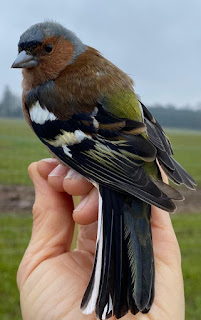It's a very strange time at the moment. Reports from far and wide tell of very poor numbers at feeding stations-as we are finding. However, as I've said before, it's testament to the enthusiasm and hard work of our team that modest numbers are still building because of their efforts.
Gareth got out for the first time in a while this morning and caught his first Cetti's Warbler of the year. They are pretty special birds, at the northern edge of their distribution--and increasing--even if they are not particularly special to look at...
Continuing the warbler theme, Gareth also caught his first Chiffchaff of the year. Again, a pretty sombre coloured species--but the excitement they engender is palpable--Spring migration is with us!!
Jenni and Paul have been putting in the hours too--here's just a few of the stunning images from their efforts...
Jen's doing well for Brambling as they gather ready to migrate north. This is a stunning image of a male, and shows very well the buff tips to the black head feathers before they have all worn off to expose the black breeding colour of the head.
Blackcaps ( this is a male) are arriving in big numbers at the moment. It's not often you get to see them this close--just look at the white dots along the lower 'eyelid'
One of the very common resident birds we catch quite a lot of is the Wren--but I don't think I've posted a picture of one, so.....
This time last year Paul was catching dozens of Linnet at our 'spinner' feeder, but this year they are few and far between for some reason. He has caught a few though,
Here's a super adult male with a clean grey head and plenty of red feathers on the breast. There's a cold spell in the forecast and we're hoping this may lead to an increase in the number of birds at our feeders, fingers crossed


























